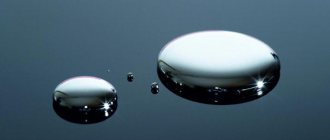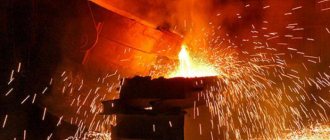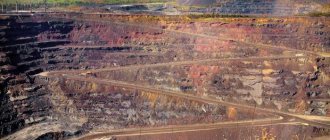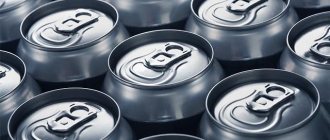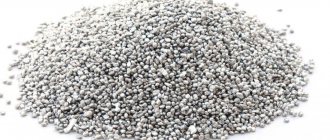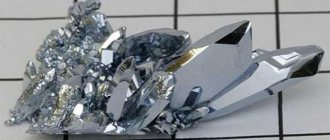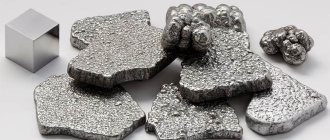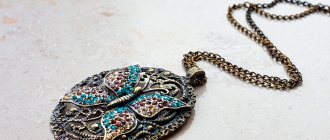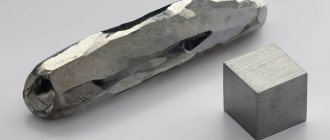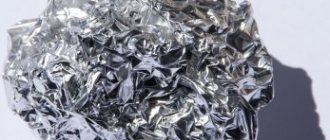Group of light non-ferrous metals
The most common methods of classifying non-ferrous metals according to their physical and chemical properties include distribution into seven groups, among which the so-called heavy and light non-ferrous metals are distinguished. This conditional definition is based on the density of the material. The main list includes aluminum, magnesium, titanium, lithium, tin, and beryllium. This group also includes cadmium, thallium, gallium, bismuth, indium and other elements. The production of light alloys is extremely energy-intensive, so enterprises specializing in this area of metallurgy are located directly near sources of cheap energy.
Specific Features
Despite belonging to a general group, different light non-ferrous metals have specific properties that distinguish them from each other, as well as determining the value of a particular material and its scope of application. To better understand these nuances, it is worth taking a closer look at the main representatives of this type of non-ferrous metal.
Perhaps the most typical example of a light non-ferrous metal, well known to the widest circle of users, is aluminum. The material is plastic and easy to process, due to which it is extremely popular in a wide range of industries - from the space and aviation industries to the manufacture of kitchenware. The oxide film reliably protects the surface of aluminum products from the negative effects of the environment and aggressive substances. The main properties include:
- high thermal and electrical conductivity;
- corrosion resistance;
- high plasticity;
- low density.
Unlike aluminum, magnesium is characterized by low ductility, therefore it is practically not considered as a structural material. It has the following properties:
- ability to form hydroxide;
- high melting point;
- increased resistance to corrosion;
- strengthening of mechanical properties.
The lightest non-ferrous metal is lithium, which is usually used for alloys and is indispensable for working with optics, lasers, and the production of anodes. In the manufacture of electrolytes for alkaline batteries, hydroxide is used, and in ceramic production, lithium silicate and aluminate are used. The properties of this element make it very useful for the metallurgical and military industries, as well as for medicine, pharmaceuticals, and the thermonuclear industry.
Chemistry of post-transition metals[ | ]
According to the second statement, transition elements either have an incomplete d-subshell or have the ability to form an incomplete d-subshell. In 2007, mercury(IV) fluoride was synthesized[6][7]. This compound contains a mercury atom with an incomplete d-subshell. By analogy with this, copernicity is predicted to have the same property, that is, it should presumably form a similar electronic configuration. In this case, the post-transition metals include only zinc and cadmium.
There is a definition, not given by IUPAC, that equates post-transition metals to d-block elements. In this case, the entire 12th group may contain transitional elements. This definition is not accepted or discussed[8].
Antimony is considered a metalloid, a metal, and sometimes a post-transition element[8]. Aluminum is neither a transition nor a post-transition metal, as it does not have a d-subshell and is located above the transition elements in the table.
Alloys containing light non-ferrous metals
In its pure form, non-ferrous metal is not used as often as it is used as components of various alloys. For example, the well-known bronze is nothing more than a combination of copper with aluminum, tin, manganese, lead and a number of other elements. Due to its good casting characteristics, the material is widely used for the manufacture of plumbing equipment (valves, taps), lighting devices, decorative items and other products.
Silumin also has high casting characteristics, combining the properties of aluminum and silicon - ductility, flexibility, hardness. By modification, these mechanical characteristics of silumins can be significantly improved due to an increase in the degree of dispersion of the crystals. Another alloy with an aluminum base is duralumin. Along with aluminum, there are manganese, copper, silicon, magnesium and other elements belonging to different groups. The technical properties of duralumin are increased through heat treatment.
Rolled metal
Light metals include metals whose density is less than 4500 kg/m3. The most widely used light metals include aluminum, magnesium and titanium.
Aluminum
- silvery-white metal with a somewhat dull surface coated with a film of oxide. Its density is 2700 kg/m3, melting point 660°C. The main properties of aluminum are lightness, ductility, high electrical and thermal conductivity, frost resistance, corrosion and chemical resistance (resistant to organic and nitric acid), good weldability and processing by rolling, forging and drawing.
Aluminum is the most common metal in the earth's crust. However, due to its high chemical activity in the free state, it is not found in nature, but is concentrated in bauxites, nephelines, kaolins, alunites, etc. The most valuable ore, containing up to 50% aluminum oxide, is bauxite. An intermediate product of the chemical processing of aluminum ores is alumina. Metal is obtained from it through electrolysis.
Technical aluminum is produced in ingots. Depending on the chemical purity, the following grades of aluminum are distinguished:
§ special purity - A999 (impurities no more than 0.001%);
§ high purity - A995, A99, A97, A95 (impurities 0.005-0.05%);
§ technical purity - A85, A8, A7, A6, A5, AO, AE (impurities 0.15-1.0%).
Aluminum of high purity is used in semiconductor and nuclear technology, high purity - for the manufacture of electrical capacitors, chemical equipment, technical purity - for the manufacture of cable products, rolled products, tableware, aluminum powder and powder, as well as alloys.
As a structural material, aluminum is mainly used in the form of alloys. This is explained by its low mechanical properties, difficulty in cutting, as well as significant linear shrinkage. The main components of aluminum alloys are manganese, copper, silicon, magnesium, zinc, titanium, chromium, etc.
Aluminum alloys are divided into wrought alloys (for the production of sheets, strips, pipes, profiles, etc.), foundry alloys (for producing castings), solders (for soldering aluminum alloys) and bearing alloys.
Deformable
Aluminum alloys have high ductility, as a result of which they can be easily processed by pressure, are well welded, and are resistant to corrosion. Depending on the ability to be strengthened by heat treatment, they are divided into alloys that cannot be strengthened and those that can be strengthened by heat treatment (hardening, aging, annealing).
Alloys that cannot be strengthened by heat treatment include technical aluminum (AD0 and AD1), as well as alloys of aluminum with magnesium (magnalium) or manganese (AMg2, AMg3, AMg5, AMg6, AMts). They are strengthened only by cold deformation and are used for welded and riveted parts of structures operated under relatively light loads and in corrosive environments. Alloys that can be strengthened by heat treatment include duralumin, aviali, high-strength, forging and heat-resistant.
Duralumins are alloys of aluminum with copper, magnesium and manganese. They are produced in grades D1, D16p; D18p, VD17, D19, V65 and are used for the manufacture of parts of medium and high strength, subject to variable loads (parts of aircraft, cars, building structures, etc.).
Aviali - alloys of aluminum with magnesium and silicon. They are produced in grades AB, AD31, AD33, AD35 and are used for the manufacture of parts of medium strength, as well as parts subject to flexible deformation in both cold and hot states (blades, helicopter propellers, engine parts , ship bulkheads, electric motor housings, pipelines, etc.).
High-strength alloys are alloys consisting of aluminum, zinc, magnesium, copper, manganese and chromium. They are produced in the brands B92, B93, B94, B95, B96, VAD23. Their disadvantage is reduced corrosion resistance.
Forging alloys are characterized by high ductility at temperatures of 380-450°C and therefore are used for the manufacture of stampings and forgings of complex shapes, medium and high strength, and low corrosion resistance. These include alloys of the AK6 and AK8 grades.
Heat-resistant alloys are used for the manufacture of parts operating at temperatures up to 300°C (cylinder heads, pistons, parts of compressors and turbojet engines, skin of supersonic aircraft, etc.). These include alloys of the AK2, AK4, AK4-1, D20 and D21 grades.
Foundry
aluminum alloys have high fluidity, low shrinkage, good mechanical properties and corrosion resistance, which is achieved by introducing into their composition a larger amount of alloying elements compared to deformable alloys.
Depending on the main components, cast aluminum alloys are produced in five groups, including alloys based on aluminum and magnesium (AL8, AL13, AL22, AL23, AL27, AL29), aluminum and silicon (AL2, AL4, AL4V, AL7, AL78, AL9 , AL9V), aluminum and copper (AL7, AL7V, AL 19), aluminum, silicon and copper (AL3, AL5, AL6, AL10V, AL4M, AL32, etc.) and multicomponent (AL1, AL 16V, AL17V, AL18V, AL20 , AL21, AL24, AL25, AL26, AL30).
The most common cast aluminum alloys are silumins (alloys based on aluminum and silicon).
To improve the characteristics of cast aluminum alloys, they are refined (treated with a mixture of chloride and fluoride salts of potassium and sodium or neutral gases (nitrogen, chlorine, argon) in order to reduce the content of gases and non-metallic impurities) or modified (treated with a mixture of sodium fluoride and chloride salts in order to improving the structure of silumins and increasing their mechanical and casting properties).
Bearing
aluminum alloys are produced in grades A03-1, A09-2, A020-1, etc.
In the marking of aluminum alloys, letters indicate components (A - aluminum, K - silicon, Mts - manganese, Mg - magnesium), purpose (D - wrought, L - casting) or properties (B - high-strength, M - soft annealed, Π - semi-hardened , H—cold-hardened). The letter D also denotes duralumin. The numbers following the letters of the marking indicate either the serial number of the alloy or the percentage of the corresponding element. For high-strength alloys, the number 9 is placed in the first place of the digital marking.
Magnesium is a silver-white, coated with an oxide film, metal with a density of 1740 kg/m3, melting point 651°C. The main properties of magnesium are low density (one of the lightest metals), good machinability, resistance to kerosene, gasoline and mineral oils, but it is not stable in aqueous solutions of salts, except fluoride, and dissolves in many acids. Magnesium is non-magnetic, has low casting and elastic properties, and corrodes in humid air. Powdered magnesium or magnesium strip ignites easily with a match and burns with a white flame.
In nature, magnesium occurs in the form of carbonates, silicates, chlorides and sulfates. To obtain it, magnesite, dolomite, carnallite, bischofite and waste from some industries are used.
Magnesium is produced in the grades Mg96 (at least 99.96% Mg), Mg95 (at least 99.95% Mg) and Mg90 (at least 99.90% Mg) in the form of ingots weighing up to 8 kg. It is used as a component of ultra-light and heat-resistant alloys, high-strength cast iron, in the chemical industry and pyrotechnics.
Magnesium alloys
are compounds of magnesium with aluminum, zinc, manganese and other metals.
They are produced as cast
(ML2, ML15, ML19) and
deformable
(MAl, MA2, MA8, etc.). The number in the marking indicates a serial number, depending on the chemical composition.
Titanium is a silver-colored metal with a bluish tint, density 4505 kg/m3, melting point 1668°C. It is characterized by high strength properties (at temperatures up to 400°C), corrosion resistance, including in many aggressive environments, low thermal and electrical conductivity, and non-magnetic. The mechanical properties of titanium decrease when heated to temperatures above 400°C, and at a temperature of 540°C it becomes brittle.
The starting materials for titanium production are ilmenite, rutile, sphene or titanite, perovskite, etc.
Technical titanium
The grades BT1-00 (99.53% Ti), BT1-0 (99.48% Ti) and BT1-1 (99.44% Ti) are produced. The fewer impurities, the lower the strength, but the higher the ductility. Technical titanium is well processed by pressure and welded (in an argon environment), but its cutting processing is difficult.
To increase the mechanical properties and corrosion resistance, titanium is alloyed with aluminum, molybdenum, vanadium, manganese, chromium, tin, niobium, etc. The resulting alloys are divided according to strength into high ductility, low
and
medium strength
and
high strength, and
according to their intended purpose - for
casting
(BT1L, VT5L, VT6L, etc.) and
deformable
(from 4-0, VT5-1, VT8, VT9, VT22, etc.) The numbers in the marking indicate the average percentage alloy components.
Titanium alloys
used in chemical engineering (columns, towers, adsorbers, filters, pumps, heat exchangers operating in chlorine and its solutions, in nitric acid), aircraft engineering (aircraft skins, engine parts), rocketry, shipbuilding, heavy and power engineering, for manufacturing of household appliances, etc.
Features of delivery of light alloys
Currently, individuals and legal entities have the opportunity to make a profit from delivering non-ferrous metal to specialized collection points. The cost of scrap is determined by a number of factors, including the quality of the material, the purity of its chemical composition, category and other parameters. Current prices on the market and the tariffs of a specific host company are also important.
The formal side of the issue of handing over any scrap, including light non-ferrous metals, has its own specifics. Everyone has the right to such an event, but it is implemented in different ways. For example, if the delivery of non-ferrous metal is carried out by a legal entity - an organization, an enterprise or a representative of a small business (IE), then a special license will be required. This requirement does not apply to individuals, but several rules should be taken into account:
- Only your own scrap is allowed for acceptance (with documents confirming the right of ownership);
- the non-ferrous metal to be handed over must be included in the register of materials accepted without a license;
- Delivering scrap to illegal collection points can have very unpleasant consequences in accordance with current legislation.
In addition to purely mercantile interest, the delivery of non-ferrous metals is attractive from an environmental point of view and the conservation of natural resources. The recycled scrap is again used to manufacture the necessary products, and production from recycled materials is cheaper than using ore. Taking into account the fact that industry's need for scrap is steadily growing, while natural reserves of raw materials are rapidly declining, a closed production cycle is the most rational. Thus, everyone who donates non-ferrous metal scrap not only increases their own well-being, but also acts for the benefit of society as a whole.
